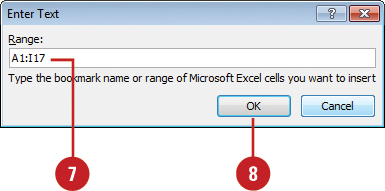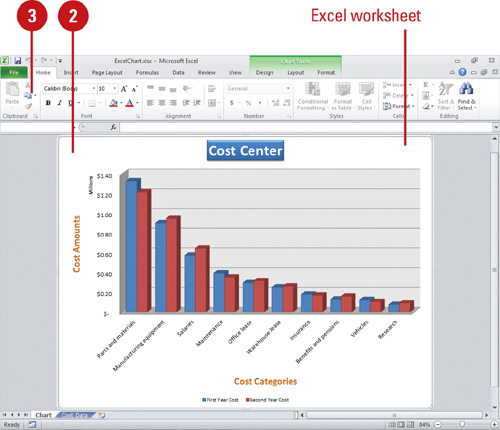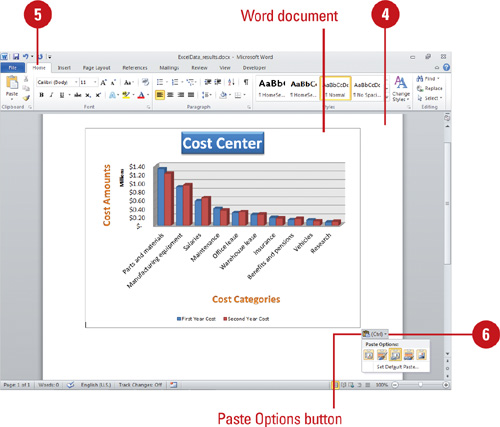A common pairing of Office programs combines Word and
Excel. As you write a sales report, explain a budget, or create a memo
showing distribution of sales, you often want to add existing
spreadsheet data and charts to your text. Instead of re-creating the
Excel data in Word, you can insert all or part of the data or chart into
your Word document. You can use the Object button on the Insert tab or
copy and paste the information from Excel into Word. The Paste Special
command allows you to specify how you want to paste external information
into Word. After you insert data or a chart into your word document,
you can double-click the embedded Excel object to modify the data or
chart.
Insert an Excel Worksheet Range to a Word Document
 Click in the Word document where you want to copy the Excel range. Click in the Word document where you want to copy the Excel range.
 Click the Insert tab. Click the Insert tab.
 Click the Object button arrow, and then click Text from File. Click the Object button arrow, and then click Text from File.
 Click the Files of type list arrow, and then click All Files. Click the Files of type list arrow, and then click All Files.
  Locate and select the file name of the workbook you want to copy. Locate and select the file name of the workbook you want to copy.
 Click Range. Click Range.
 Specify the range you want. Specify the range you want.

 Click OK. Click OK.
 Click Insert. Click Insert.
You can name a range to make it easier to use in Word.
If you plan to insert part of an Excel worksheet in a Word document,
name the range. This is easier to recall than the specific cell
references. Check Help in Microsoft Excel for details.
Copy Data from Excel
 Open both the Word document and the Excel worksheet that contain the data you want to link or embed an object. Open both the Word document and the Excel worksheet that contain the data you want to link or embed an object.
 Switch to Excel, and then select the entire worksheet, a range of cells, or the chart you want. Switch to Excel, and then select the entire worksheet, a range of cells, or the chart you want.

 Click the Home tab, and then click the Copy button. Click the Home tab, and then click the Copy button.
 Switch to the Word document, and then click where you want the information to appear. Switch to the Word document, and then click where you want the information to appear.
  Click the Home tab. Click the Home tab.
 Use either of the following methods. Use either of the following methods.
- Paste. Click the Paste button, click the Paste Options button, point to a paste option icon to display a ScreenTip with the function name and display a preview of the data (New!), and then select an option.
- Paste Special. Click the Paste button arrow, click Paste Special, click Microsoft Excel Worksheet Object, and then click OK.
You can import Excel data as a picture.
Data inserted this way becomes a table that you cannot edit. Select the
data you want to import, click the Copy button on the Home tab. Click
in the Word document where you want to insert the picture, click the
Paste button arrow on the Home tab, and then click Picture. Drag the
picture to a new location, or drag its resize handles to enlarge or
shrink it.
|